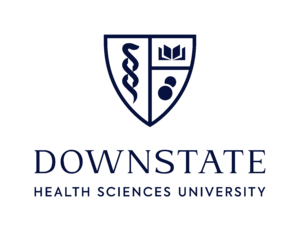SUNY Downstate Medical Center facts for kids
 |
|
| Type | Public medical school |
|---|---|
| Established | 1860 |
|
Parent institution
|
State University of New York |
| Chancellor | John B. King, Jr. |
| President | Wayne J. Riley |
| Students | 1,846 |
| Undergraduates | 211 |
| Postgraduates | 1,635 |
|
Other students
|
1,040 residents |
| Location |
,
40°39′19″N 73°56′45″W / 40.6554°N 73.9457°W |
SUNY Downstate Health Sciences University is a public medical school and hospital in Brooklyn, New York. It is part of the State University of New York (SUNY) system. It is the only medical center in Brooklyn that focuses on health education, research, and patient care for the borough's 2.5 million people.
SUNY Downstate is made up of several schools. These include a College of Medicine, a College of Nursing, and schools for graduate studies, health professions, and public health. The university also has a large hospital called the University Hospital of Brooklyn. It is a major center for research and has modern labs for science and technology.
Contents
History of the University
The university's story began in 1856. A group of doctors started a free clinic in Brooklyn to help care for poor immigrant families. At first, it was called the German General Dispensary. It was created to help German families, but it soon began helping people from all backgrounds.
In 1858, the clinic officially became the Long Island College Hospital. It was a new kind of school where students learned about medicine by helping patients in the hospital. This was a revolutionary idea at the time. Soon, other medical schools started teaching this way too.
The school opened in 1860 with 57 male students. It was one of the few medical schools that accepted African American students. One of its famous teachers was Dr. Austin Flint Sr., who helped make the stethoscope a common tool for doctors in the United States.
Over the years, the school grew. It started to accept women and offer more advanced training. In 1950, the school joined the State University of New York (SUNY) system. It became known as "Downstate" to tell it apart from another SUNY medical school in Syracuse, which is called "Upstate".
The current campus in the East Flatbush neighborhood of Brooklyn was built in the 1950s and 1960s. In 1954, President Dwight D. Eisenhower attended the ceremony for the first building. Later, the University Hospital of Brooklyn was added, along with other schools and student buildings.
Studying at SUNY Downstate
Most of the students at SUNY Downstate come from the New York City area. The university offers over 30 different programs focused on health and medicine. Students can study to become doctors, nurses, researchers, and other healthcare professionals.
Caring for Patients
University Hospital of Brooklyn
| University Hospital of Brooklyn | |
|---|---|
| Geography | |
| Location | 450 Clarkson Avenue Brooklyn, New York City, United States |
| Organization | |
| Hospital type | Teaching |
| Affiliated university | SUNY Downstate College of Medicine |
The University Hospital of Brooklyn (UHB) provides advanced medical care to people all over Brooklyn. The main hospital has eight floors, 12 operating rooms, and emergency rooms for both adults and children. It also has 75 outpatient clinics where people can see a doctor without staying overnight.
UHB also has health centers in other Brooklyn neighborhoods, like East New York and Bedford-Stuyvesant. This helps bring healthcare closer to where people live.
Special Programs for the Community
SUNY Downstate has special programs to help the community.
- HEAT Program: The HEAT (Health and Education Alternatives for Teens) program provides special healthcare and support for young people. It was started by Dr. Jeffrey Birnbaum to help teens stay healthy.
- Brooklyn Free Clinic: This is a free clinic run by medical students. It offers medical care to people in Brooklyn who do not have health insurance. The clinic has won awards for its work in the community.
- SUNY Downstate at Bay Ridge: This location serves several communities in Brooklyn. It has an Urgent Care Center for immediate medical needs and provides many other medical services.
Medical Research
SUNY Downstate is a top research center where scientists study important health problems. They work on everything from how the brain learns to finding new ways to treat heart disease. Researchers at Downstate also develop new technologies, like robotic prosthetic devices (artificial limbs) and special imaging tools to see inside the body.
The university plays a big role in "bench to bedside" research. This means that discoveries made in the science lab ("the bench") are used to create new treatments for patients ("the bedside"). In 2011, the university received over $60 million in funding for its research projects.
Famous Teachers and Discoveries
Many important doctors and scientists have worked at SUNY Downstate.
- Alexander Skene, MD: He was an expert on women's health. In 1880, he discovered glands that are now named after him (Skene's glands).
- Robert L. Dickinson, MD: He was a doctor who published one of the first modern pamphlets on family planning in 1931.
- Robert Furchgott, PhD: He won the Nobel Prize in Medicine in 1998 for his research on a gas called nitric oxide and how it works in the body.
See also
- University Hospital of Brooklyn at Long Island College Hospital
- State University of New York Upstate Medical University


